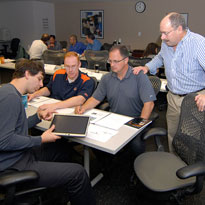LTE: Emergency, Priority Access, Public Safety Support
- Course:LTE: Emergency, Priority Access, Public Safety Support
- Course ID:LTE-PUBSAFE Duration:4 days Where: Your Office (7+ Persons)
- Download Course Description (PDF)
Available as a private, customized course for your group at your offices or ours and in some cases as a WebLive(TM) class.
Course Outline
- 4G/LTE Requirement Roadmap and Standardization
- Introduction to LTE
- LTE/EPC Network Architecture, Protocols, and Components
- UE
- eNB
- MME
- S-GW
- P-GW
- LTE/EPC Key Interfaces
- IMS in LTE
- LTE Air Interface Basics
- OFDM/OFDMA/SC-FDMA Essentials
- LTE Numerology
- LTE Physical, Transport, and Logical Channels
- LTE RRC Layer Including Signaling and Broadcast
- Idle Mode Operation, Paging, and Tracking Area Update
- LTE/EPC Network Architecture, Protocols, and Components
- Network Entry and Attachment
- System Acquisition/Scanning
- Synchronization
- Default Bearer Establishment
- Random Access in LTE
- eNB Access Barring
- Handover in LTE
- X2-Based and S1-Based Handoff
- LTE Interworking with 3GPP and 3GPP2 networks
- Roaming
- QoS Management
- Different Classes of Services and Their Priorities
- Scheduling in LTE
- Scheduling for Emergency/Public Safety devices
- Default and Dedicated Bearers, Their Establishment and Modification/Release
- Priority Access in Network Architecture (PCRF, etc)
- Congestion Control in LTE
- Congestion Control in LTE Air interface
- Congestion Control at the Transport
- Congestion Control at the Core Network
- Other Consideration in LTE
- LTE VoIP
- CSFB Voice
- SRVCC for Voice Service Continuity over IMS
- One Voice or VoLTE for VoIP over LTE over IMS
- LTE PWS (Public Warning Systems)
- ETWS: Earthquake and Tsunami Warning System
- CMAS: Commercial Mobile Alert System
- LTE VoIP
- Wrap-up
- Course Recap and Q/A
- Evaluations
Course in a Nutshell
3GPP LTE is one of the two broadband mobile wireless technologies meeting all of the ITU IMT-Advanced 4G requirements. It provides a high-capacity, flat IP, mobile data network based on OFDMA/MIMO with low latency that is suitable for many forms of multimedia delivery. It has a flatter architecture, offering the network operators lower cost per byte. LTE interfaces with IMS to provide architecture, framework, and QoS mechanisms for applications/services including voice and video (conversational, streaming, and conferencing), gaming, and instant messaging. Consequently, LTE is becoming the de-facto worldwide standard for mobile broadband.
Since LTE provides a flexible platform for all types of 4G communications, it behooves us to examine its suitability for public safety applications. Public safety organizations require data communications paths that are reliable at all times, so that in the event of an emergency, e.g., a natural disaster or act of terrorism, all real-time and mission-critical data transmission in and out of the incident zone can be guaranteed timely reception, without suffering network congestion. As we will learn in this course, LTE can be deployed to meet these critical requirements, either using a public commercial network or a private network designed specifically to provide the types of services needed by public safety organizations.
Customize It!
We can customize this course to add or delete topics or adjust its “tech level” up or down to meet the needs of your group.
Aimed At
This course is aimed at federal, state, and local public safety and law enforcement organizations, and companies who work with them, who wish to better understand how LTE may be leveraged for public safety communications.
Prerequisites
Those wishing to take this course should have a working knowledge of wireless technologies through UMTS/HSPA either through job experience or prior training.
- "Covered a lot of information; instructor very knowledgeable, easy to understand, very personable, and extremely helpful. Class was very beneficial." – Electrical Engineer, US Department of Homeland Security

